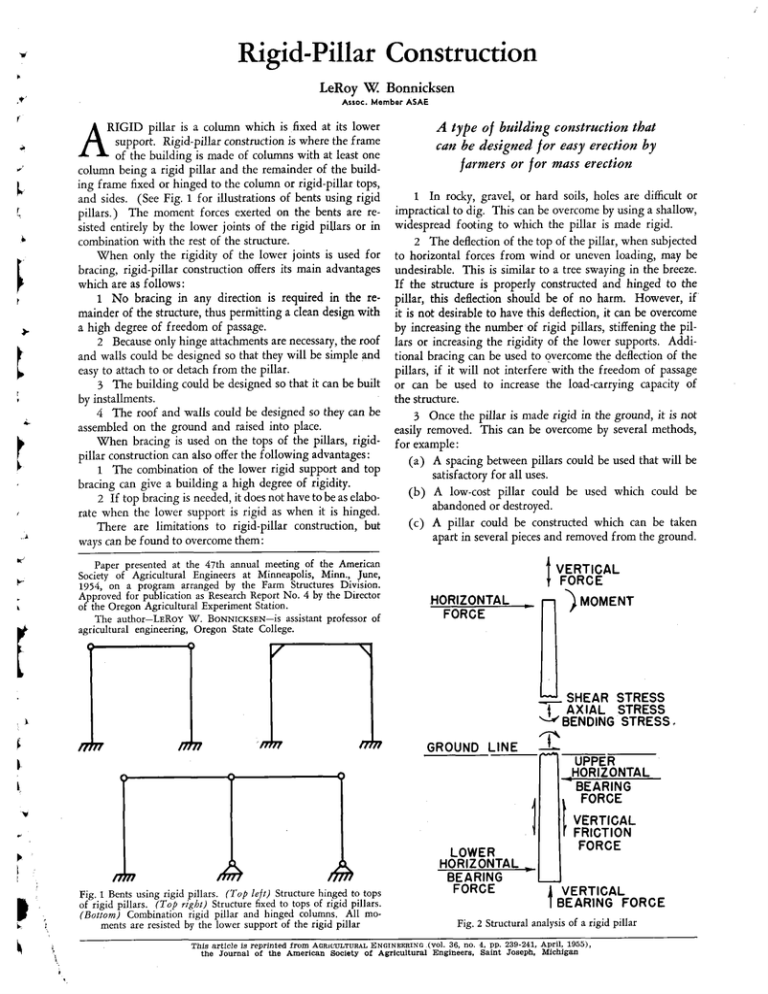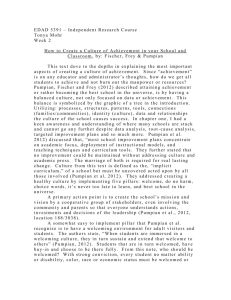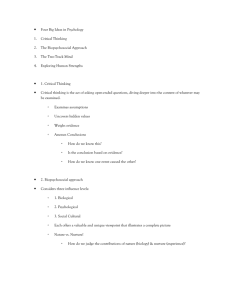A Rigid-Pillar Construction A type of building construction that
advertisement

Rigid-Pillar Construction LeRoy W. Bonnicksen Assoc. Member ASAE RIGID pillar is a column which is fixed at its lower A support. Rigid-pillar construction is where the frame of the building is made of columns with at least one column being a rigid pillar and the remainder of the building frame fixed or hinged to the column or rigid-pillar tops, and sides. (See Fig. 1 for illustrations of bents using rigid pillars.) The moment forces exerted on the bents are resisted entirely by the lower joints of the rigid pillars or in combination with the rest of the structure. When only the rigidity of the lower joints is used for bracing, rigid-pillar construction offers its main advantages which are as follows: 1 No bracing in any direction is required in the remainder of the structure, thus permitting a clean design with a high degree of freedom of passage. 2 Because only hinge attachments are necessary, the roof and walls could be designed so that they will be simple and easy to attach to or detach from the pillar. 3 The building could be designed so that it can be built by installments. 4 The roof and walls could be designed so they can be assembled on the ground and raised into place. When bracing is used on the tops of the pillars, rigidpillar construction can also offer the following advantages: 1 The combination of the lower rigid support and top bracing can give a building a high degree of rigidity. 2 If top bracing is needed, it does not have to be as elaborate when the lower support is rigid as when it is hinged. There are limitations to rigid-pillar construction, but ways can be found to overcome them: se Paper presented at the 47th annual meeting of the American Society of Agricultural Engineers at Minneapolis, Minn., June, 1954, on a program arranged by the Farm Structures Division. Approved for publication as Research Report No. 4 by the Director of the Oregon Agricultural Experiment Station. The author—LEROY W. BONNICKSEN—is assistant professor of agricultural engineering, Oregon State College. A type of building construction that can be designed for easy erection by farmers or for mass erection 1 In rocky, gravel, or hard soils, holes are difficult or impractical to dig. This can be overcome by using a shallow, widespread footing to which the pillar is made rigid. 2 The deflection of the top of the pillar, when subjected to horizontal forces from wind or uneven loading, may be undesirable. This is similar to a tree swaying in the breeze. If the structure is properly constructed and hinged to the pillar, this deflection should be of no harm. However, if it is not desirable to have this deflection, it can be overcome by increasing the number of rigid pillars, stiffening the pillars or increasing the rigidity of the lower supports. Additional bracing can be used to overcome the deflection of the pillars, if it will not interfere with the freedom of passage or can be used to increase the load-carrying capacity of the structure. 3 Once the pillar is made rigid in the ground, it is not easily removed. This can be overcome by several methods, for example: (a) A spacing between pillars could be used that will be satisfactory for all uses. (b) A low-cost pillar could be used which could be abandoned or destroyed. A pillar could be constructed which can be taken (c) apart in several pieces and removed from the ground. VERTICAL FORCE HORIZONTAL FORCE ) MOMENT f SHEAR STRESS AXIAL STRESS `.--*/ BENDING STRESS .0••n••••n /717/ /7777 /7777 0 0 A GROUND LINE UPPER HORIZONTAL BEARING FORCE 0 /7777 Fig. 1 Bents using rigid pillars. (Top left) Structure hinged to tops of rigid pillars. (Top right) Structure fixed to tops of rigid pillars. (Bottom) Combination rigid pillar and hinged columns. All moments are resisted by the lower support of the rigid pillar LOWER HORIZONTAL BEARING FORCE VERTICAL FRICTION FORCE VERTICAL BEARING FORCE Fig. 2 Structural analysis of a rigid pillar This article is reprinted from AGRICULTURAL ENGINEERING (v01. 36, no. 4, pp. 239-241, April, 1955), the Journal of the American Society of Agricultural Engineers, Saint Joseph, Michigan Fig. 3 (Left) Shed roof • Fig. 4 (Right) Gable roof, ridge support Fig. 9 (Left) Gable roof, low trussed ridge • Fig. 10 (Right) Combination roof, high trussed ridge, side lean-to "01 F g. 5 (Lef ) Gable roof, cantlever ridge • roof, ridge support Fig. 6 (Right) Gab e walls •• Fig. 12 (Right) Gable roof, Fig. 11 (Left) Rigtol-pllar high trussed ridge 4 Fig. 7 (Left) Combination roof, ridge support • Combination roof, ridge support Fig. 8 (Right) Fig. 13 Monitor roof, high trussed ridge side lean tos Some materials which could be used for footing and In the structural analysis of the rigid pillar (Fig. 2) horizontal bearing developers, if needed, are poured conthere are three groups of forces to consider which are: crete, special masonry blocks, treated timbers, well-graded 1 The loading forces. They are created by the dead, gravel, and metal plates. snow, live and wind loads. They can be resolved into a Because of the large concentrated vertical design loads, horizontal force, a vertical force and a moment. The moment is created by the vertical forces acting away from the vertical the attachment joint of the roof to the top of the pillar is center line and by the transfer of moments from other struc- very important. Many pole-frame buildings have been put up where this joint is the weakest part of the structural detural members through non-hinged joints, if any. sign. Because this joint in most cases needs only to be a 2 The stresses in the pillar. They can be resolved into hinge or pin connection, many designs could be developed axial, shear and bending stresses. If the structure is fastened to the pillar by hinges, the pillar is structurally a cantilever. which will be satisfactory. Many different types of roof design can be made for This would put the greatest combination of stresses at the ground line; therefore, that is where the pillar would need rigid-pillar construction. In some of the present permanent designs, the roofing is applied to either purlins (horizontal to be the strongest. 3 The bearing forces of the soil. They can be resolved longitudinals) or rafters (slanting laterals). The purlins into upper and lower horizontal bearing forces, and vertical are supported by large rafters which are attached to the friction and bearing forces. Because of the wide variation pillars, or the purlins are supported by a combination of in soil conditions, this group of forces is the most difficult to part of the rafters attached to the pillars and the remaining study. Soil mechanics is involved in this study, and if ex- rafters supported by larger purlins which are also attached to pertly used it can aid in the design of an economical and adequate rigid pillar. The depth of the pillar in the ground is the most important factor in the rigidity of the pillar. The size of the pillar does not affect the rigidity of the pillar in good bearing soils but does affect the rigidity in poor bearing soils. In the case where the pillar does not have the size or depth to develop the required bearing forces, footings and horizontal bearing developers may need to be added. There are many materials or combinations of materials which could be used for a rigid pillar. The one that is the most popular and commonly used is the pressure-treated wood pole. However, the other materials that could be satisfactorily used are post-tension concrete or clay block, pretension or reinforced concrete, steel girder or pipe and pressure-treated square wood posts 9r 14Minated timber§, Fig. 14 A rigid-pillar frame design for a multiuse barn 4 the pillars. The rafters are supported by larger purlins which are attached to the pillars, or the rafters are supported by a combination of part of the purlins attached to the pillars and the remaining purlins supported by large rafters which are also attached to the pillars. The roof design, in which the order of support is roofing to purlin to rafter to rigid pillar, offers several advantages which are as follows: 1 This design is desirable for wide, clear, lateral spans because the rafters can be trussed. 2 Many cross-sectional shapes can be made (Figs. 3 through 13). 3 This roof design permits top bracing in the lateral direction if needed. Usually the wind forces cause more moment per rigid pillar in the lateral direction than in the longitudinal direction; therefore, if any top bracing is needed, it will usually be in the lateral direction. 4 Some of the combinations can be built by installments. 5 Standard rafters, trussed rafters, attachments to pillar, purlins, pillar spacings, rigid pillars, roofing and walls can be designed for economical mass erection, installment building, changing the size and shape of the building, and for prefabrication. Plank and beam roof construction works very well with rigid-pillar construction. The planks are fastened to the beams which are attached to the pillars. To obtain wider spacing between pillars, the intermediate beams can be supported by girders attached to the pillars. Other roof designs which use the advantages of rigidpillar construction to obtain more flexibility and ease of erection can be made. They are as follows: 1 A design where all the connections of the frame members and roofing application would be of the types of pin connections which are easy to assemble and take apart. 2 A design where the roof is made into prefabricated sections which are lifted into place and assembled. 3 A design where the roof is assembled on the ground and lifted as a whole unit or in sections into place. This design could also permit raising the roof to a greater height, a lower height, or to the ground at a later time. To gain greater flexibility, the wall can be designed so that it can be made into panels which can be easily attached or detached by pin connections to the pillar. For the more permanent type of wall construction, horizontal girts are attached to the pillars and vertical siding is attached to the girts. The bottom of the walls may have to be a different type of construction and material to meet the greater requirements. The floor can be of dirt, gravel, asphalt or concrete slab. If concrete is placed directly around the pillar, it can be considered as the upper bearing area and will greatly add to the stiffness of the pillar. However, unless means are made to remove a small section of the slab from around the pillar, a solid-type pillar is difficult to be removed or replaced. Several types of cornices are used, as follows: 1 Open type for constant ventilation 2 Closed type for no ventilation 3 Adjustable type to control amount of ventilation desired. This latter type should be the most desirable and can easily be incorporated into a design. A building made of rigid-pillar construction can be designed for easy erection by the farmer or for mass erection by a building erector with special tools and equipment. The erection will usually be in the following order: After the site is chosen, the location of each pillar will be staked out. Holes will be dug at each pillar. For this job a larger posthole digger will be of great aid. The holes are then cleaned and the footing put in. The pillars are next erected with the method depending on whether the pillar is completely assembled before erection or during the erection. The assembled pillars are put into the holes, located in place, plumbed and partially packed to be held in place but still capable of being moved slightly. Then when enough of the main roof members are put in, to properly space the tops of the pillars and square the building, the pillars are firmly packed. Pillars which are assembled during the erection should be plumbed and packed as they are assembled. Next, the roof is erected, followed by the walls. The walls could be put up before the roof but because they are not needed for the roof support, they are put on after the roof to make it easier for the roof erection. A tractor crane and a traveling scaffold would be good equipment for the pillar, roof and wall erection. The floor slab, if any, can be placed any time after the pillars are plumbed and packed.



